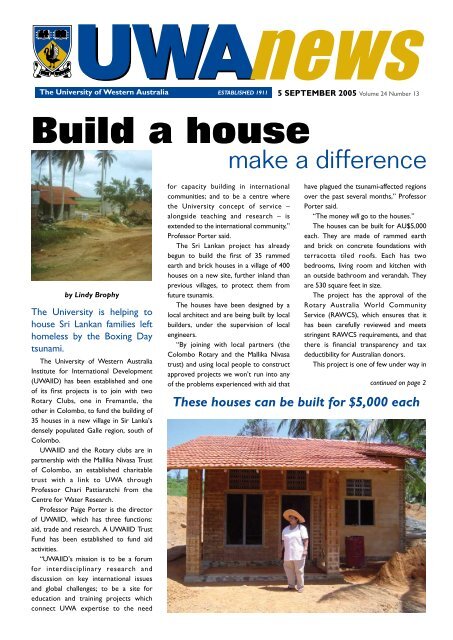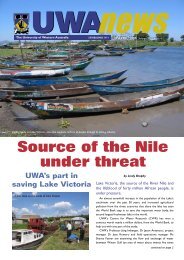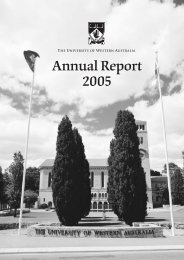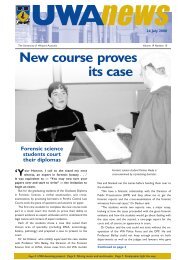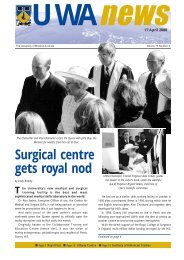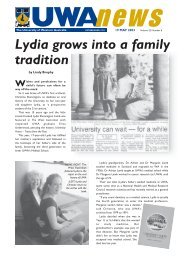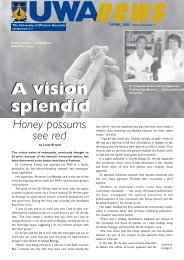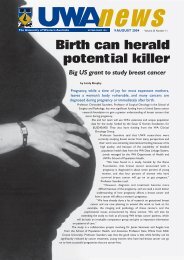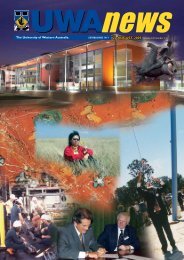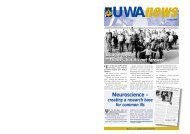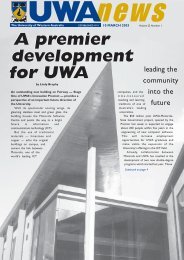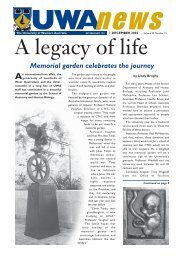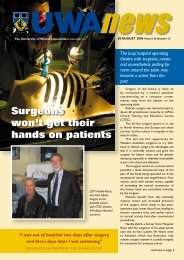5 Sep: Vol 24, #13 - UWA News staff magazine - The University of ...
5 Sep: Vol 24, #13 - UWA News staff magazine - The University of ...
5 Sep: Vol 24, #13 - UWA News staff magazine - The University of ...
Create successful ePaper yourself
Turn your PDF publications into a flip-book with our unique Google optimized e-Paper software.
<strong>UWA</strong> 1911newsEstablished<strong>UWA</strong><strong>The</strong> <strong>University</strong> <strong>of</strong> Western Australia5SEPTEMBER 2005 <strong>Vol</strong>ume <strong>24</strong> Number 13Build a houseby Lindy Brophy<strong>The</strong> <strong>University</strong> is helping tohouse Sri Lankan families lefthomeless by the Boxing Daytsunami.<strong>The</strong> <strong>University</strong> <strong>of</strong> Western AustraliaInstitute for International Development(<strong>UWA</strong>IID) has been established and one<strong>of</strong> its first projects is to join with twoRotary Clubs, one in Fremantle, theother in Colombo, to fund the building <strong>of</strong>35 houses in a new village in Sir Lanka’sdensely populated Galle region, south <strong>of</strong>Colombo.<strong>UWA</strong>IID and the Rotary clubs are inpartnership with the Mallika Nivasa Trust<strong>of</strong> Colombo, an established charitabletrust with a link to <strong>UWA</strong> throughPr<strong>of</strong>essor Chari Pattiaratchi from theCentre for Water Research.Pr<strong>of</strong>essor Paige Porter is the director<strong>of</strong> <strong>UWA</strong>IID, which has three functions:aid, trade and research. A <strong>UWA</strong>IID TrustFund has been established to fund aidactivities.“<strong>UWA</strong>IID’s mission is to be a forumfor interdisciplinary research anddiscussion on key international issuesand global challenges; to be a site foreducation and training projects whichconnect <strong>UWA</strong> expertise to the needmake a differencefor capacity building in internationalcommunities; and to be a centre wherethe <strong>University</strong> concept <strong>of</strong> service –alongside teaching and research – isextended to the international community,”Pr<strong>of</strong>essor Porter said.<strong>The</strong> Sri Lankan project has alreadybegun to build the first <strong>of</strong> 35 rammedearth and brick houses in a village <strong>of</strong> 400houses on a new site, further inland thanprevious villages, to protect them fromfuture tsunamis.<strong>The</strong> houses have been designed by alocal architect and are being built by localbuilders, under the supervision <strong>of</strong> localengineers.“By joining with local partners (theColombo Rotary and the Mallika Nivasatrust) and using local people to constructapproved projects we won’t run into any<strong>of</strong> the problems experienced with aid thathave plagued the tsunami-affected regionsover the past several months,” Pr<strong>of</strong>essorPorter said.“<strong>The</strong> money will go to the houses.”<strong>The</strong> houses can be built for AU$5,000each. <strong>The</strong>y are made <strong>of</strong> rammed earthand brick on concrete foundations withterracotta tiled ro<strong>of</strong>s. Each has twobedrooms, living room and kitchen withan outside bathroom and verandah. <strong>The</strong>yare 530 square feet in size.<strong>The</strong> project has the approval <strong>of</strong> theRotary Australia World CommunityService (RAWCS), which ensures that ithas been carefully reviewed and meetsstringent RAWCS requirements, and thatthere is financial transparency and taxdeductibility for Australian donors.This project is one <strong>of</strong> few under way incontinued on page 2<strong>The</strong>se houses can be built for $5,000 each
make a differencecontinued from page 1<strong>UWA</strong>newsthe tsunami-affected area, due to bureaucratic hold ups and strikes by key people such assurveyors. Funds are needed now to enable the team to buy materials and pay labourersand the supervising engineer.Donations <strong>of</strong> $5,000 or more will be recognised with a plaque on a completed houseand a photo <strong>of</strong> the house, with an invitation to visit the family who will be housed there.“So we hope there will be quite a few houses with <strong>UWA</strong> plaques on them,” Pr<strong>of</strong>essorPorter said.“We are hopeful that we will be able to make more contributions further down theline. For example, the local community has flagged a need for some children’s playgroundson the land now left vacant between the ocean and the new villages.”<strong>The</strong> Sri Lanka project is just one <strong>of</strong> <strong>UWA</strong>IID’s activities. One <strong>of</strong> the aid objectives isto develop procedures for facilitating <strong>staff</strong> participation in development projects, initiallyin health care (where there is interest from the Medical School), but eventually acrossall interested sections <strong>of</strong> the <strong>University</strong>. <strong>The</strong>y could include areas such as agriculture,engineering, architecture, business, teaching, science and social work.<strong>The</strong> institute’s goals are to help support <strong>staff</strong> who may be providing aid assistance forshort periods <strong>of</strong> time in areas <strong>of</strong> need.Pr<strong>of</strong>essor Porter encourages <strong>UWA</strong> <strong>staff</strong> to contribute to the <strong>UWA</strong>IID Trust Fund forthe Sri Lankan housing project. “This is a project where <strong>UWA</strong> can make a difference.”All donations are tax deductible. Please contact Pr<strong>of</strong>essor Porter or Jean Andersenin Hackett Hall on 6488 3017 or 6488 7044. You can email paige.porter@uwa.edu.au orjandersen@admin.uwa.edu.au for information on <strong>UWA</strong>IID or how to make a donation.Answer toblindnessis in thebloodCause and effect: Brooke Longville with a vial <strong>of</strong> blood containing genes that are contributing to age-related macular degeneration (AMD) in theeye. <strong>The</strong> monitor in the background shows an image <strong>of</strong> the back <strong>of</strong> an eye affected by AMD. Photo courtesy Chris Barry, Lions Eye InstituteThousands <strong>of</strong> people are set to donate their blood to BrookeLongville.Brooke (pictured) doesn’t work for the blood bank – she will study the blood in thehope <strong>of</strong> finding an early detection to the most common blinding eye disease in Australia.Brooke, a researcher and PhD student at the Western Australian Institute for MedicalResearch’s Laboratory for Genetic Epidemiology, has embarked on a five-year trial at theLions Eye Institute to study the genetic makeup <strong>of</strong> 5,000 people with age-related maculardegeneration (AMD).<strong>The</strong> trial’s objective is to discover if there is an early genetic indicator <strong>of</strong> AMD, andthus be able to provide treatment for the disease. About 800,000 Australians are affectedby AMD, for which there is no cure.Brooke, whose PhD is supervised by Murdoch <strong>University</strong>, will study whole genomescans <strong>of</strong> her patients’ blood and also collect other data in her quest to find a geneticanswer to AMD, which causes 60 per cent <strong>of</strong> severe vision loss in people over the age<strong>of</strong> 55.<strong>UWA</strong>newsEDITOR/WRITERLindy BrophyTel: 6488 <strong>24</strong>36 Fax: 6488 1192Email: lindy.brophy@uwa.edu.auEDITOR-IN-CHIEFColin Campbell-FraserTel: 6488 2889 Fax: 6488 1020Designed, typeset and printedby UniPrint, <strong>UWA</strong>Please note our new webaddress<strong>UWA</strong>news online: http://uwanews.publishing.uwa.edu.au/THE UNIVERSITY OF WESTERN AUSTRALIA • 5 SEPTEMBER 2005
<strong>UWA</strong>newsSmall animalsplay abig roleinmedicalresearchAnimal technician Kylie Goldstoneand Dr Malcolm Lawson, manager,Animal Facilities and Biosafety,with one <strong>of</strong> the rats which will berehoused at QEII<strong>The</strong> opening <strong>of</strong> a new biomedical researchfacility at QEII has signalled the phasing out <strong>of</strong>the old Small Animal Facility on campus.<strong>The</strong> 40-year-old facility will be gradually decommissioned untilthe new Shenton Park Facility is opened next year. Most <strong>of</strong> thecurrent small research animals housed on campus will be movedto the new facility in M block, for easy access by researchersfrom <strong>UWA</strong>, QEII and the Western Australian Institute <strong>of</strong> MedicalResearch (WAIMR).<strong>The</strong> new facility is a joint venture between <strong>UWA</strong> and WAIMRand was opened by Pr<strong>of</strong>essor Alan Pettigrew, the Chief ExecutiveOfficer <strong>of</strong> the National Health and Medical Research Council(NHMRC).“This is a great day for biomedical research,” saidPr<strong>of</strong>essor Peter Klinken, Director <strong>of</strong> WAIMR, as guestsincluding the Minister for Science, Dr Judy Edwards, gatheredat the opening.He said it had been nearly six years since WAIMR hadsubmitted an application to the NHMRC for a new small animalresearch facility. Funding <strong>of</strong> $3.3 million had been granted, aspart <strong>of</strong> nationwide $20 million medical research capital fundingprogram.Pr<strong>of</strong>essor Klinken said the new facility would enable morerapid identification and testing <strong>of</strong> genes involved in humandiseases.Pr<strong>of</strong>essor Pettigrew said it was essential to have “not onlyappropriate but excellent facilities …to maximise the productivity<strong>of</strong> the research effort. This bodes well for the future <strong>of</strong>biomedical research in WA.”Pro Vice-Chancellor (Research and Innovation) Pr<strong>of</strong>essorDoug McEachern said the new facility provided state-<strong>of</strong>-the-artanimal housing and equipment for testing <strong>of</strong> human diseases. “Akey feature is a new safer system <strong>of</strong> decontamination, using aportable high-pressure hydrogen peroxide unit, an Australian-firstin sanitation,” he said.<strong>The</strong> new facility is the first <strong>of</strong> three new biomedical researchfacilities includinga 3,000 squarem e t r e s m a l lanimal facility atthe Shenton ParkField Station. Thisfacility is beingbuilt to worldclass standardsand is due forcompletion nextyear.Pr<strong>of</strong>essor PeterKlinken …“a great dayfor biomedicalresearch”THE UNIVERSITY OF WESTERN AUSTRALIA • 5 SEPTEMBER 2005
<strong>UWA</strong>newsVice-Chancellor’scolumnRegulation ormicro-management?<strong>The</strong>re appears to be astrong relationship <strong>of</strong> inverseproportion between thelevel <strong>of</strong> Federal Governmentregulation on universities andthe amount <strong>of</strong> governmentfunding.Over the past decade, thisis evidenced by a huge increase inregulatory requirements despite adecreasing proportion <strong>of</strong> fundingcoming from the public purse, anddespite a great deal <strong>of</strong> positive rhetoricassociated with the most recentreforms <strong>of</strong> federal Education MinisterBrendan Nelson.We have now reached a state whereit is easy to argue that the requirementson universities no longer operatewithin sensible levels <strong>of</strong> regulation, butrather are under de facto control <strong>of</strong>political micro-management – dictatinghow we should do everything fromemploying our <strong>staff</strong> to winding-upcertain courses. It is fast reaching thepoint where people quite rightly areasking whether the heavy burden <strong>of</strong>compliance is worth the funds on <strong>of</strong>fer.T h i s r a n g e o f r e g u l a t o r yrequirements includes matters suchas achieving a complex system <strong>of</strong>enrolments in discipline clusterswithin the Commonwealth GrantScheme (CGS); the tying <strong>of</strong> increasesin the CGS to industrial reformsand to governance; the development<strong>of</strong> discretionary schemes such asthe Capital Development Pool, theWorkplace Productivity ReformScheme and the Collaboration andStructural Reform Fund for whichapplications must be made; thedevelopment <strong>of</strong> performance-basedfunding schemes such as the ResearchQuality Framework and the Learningand Teaching Performance Fund;quality assurance associated with theAustralian Universities Quality Agency(AUQA); and now the need to seekpermission to cease teaching particularcourses.It is my firm belief that accountabilityfor the expenditure <strong>of</strong> public moneyshould be solely based on theachievement <strong>of</strong> outcomes and not onthe activities and processes within auniversity.Perhaps a more rational (and nonpolitical)approach would see theestablishment <strong>of</strong> an (independent)authority to negotiate a series <strong>of</strong>outcomes with each university inour system, say over a three yearcycle. <strong>The</strong>se outcomes would reflectthe context and purpose <strong>of</strong> each<strong>of</strong> the institutions. <strong>The</strong>y would befunded accordingly and asked to reportannually on progress towards thoseoutcomes.In this way, institutions would bejudged on what they achieve, not howthey achieve it. As well, such a systemwould provide greater funding certaintyby doing away with the myriad <strong>of</strong>funding mechanisms through which theFederal Government seeks to regulate— or micro-manage — universities.Quality will always be important.<strong>The</strong> five yearly reviews by theAustralian Universities Quality Agency(AUQA) should be sufficient to assuregovernment that quality is beingachieved.Alan RobsonVice-Chancellor<strong>The</strong>scienceBetween a flock <strong>of</strong> sheepand tanks <strong>of</strong> marron, in aconverted shipping container,John Considine and TonyRobinson are tasting somewine.Who said the life <strong>of</strong> a wine-maker wasglamorous?<strong>The</strong>re is little glamour and a lot <strong>of</strong> hardwork, but the <strong>staff</strong> and students from theSchool <strong>of</strong> Plant Biology who are involvedin the <strong>University</strong>’s viticulture program stillenjoy it.Only postgraduate students make winefor their course studies and researchprojects, but Pr<strong>of</strong>essor John Considine,Pr<strong>of</strong>essor <strong>of</strong> Horticulture and Viticulture,said the School was developing thePr<strong>of</strong>essor John Considine and research <strong>of</strong>ficerTony Robinson put their pr<strong>of</strong>essional palatesto workTHE UNIVERSITY OF WESTERN AUSTRALIA • 5 SEPTEMBER 2005
<strong>UWA</strong>newsbehind enjoymentHonours student Luke Hipper isinvestigating the effect on aroma <strong>of</strong>using different yeasts in making winecapacity for undergraduate students tolearn winemaking at <strong>UWA</strong> – specifically atthe Shenton Park field station (betweenthe sheep and the marron).Currently, undergraduate viticulturestudents have the option <strong>of</strong> spending ayear (second semester <strong>of</strong> second yearand first semester <strong>of</strong> third year) inAdelaide at the Waite Institute, to learnthe art and science <strong>of</strong> winemaking. Ninestudents have taken that option thisyear. From next year students will alsohave the choice <strong>of</strong> attending the newMargaret River Wine Centre run byCurtin <strong>University</strong> <strong>of</strong> Technology.<strong>The</strong> wine Pr<strong>of</strong>essor Considine andTony Robinson are tasting is chardonnayfrom the ARC Linkage Evans & Tateproject.Tony, a project wine maker andproject manager for the group, was one<strong>of</strong> the first graduates from the viticulturecourse. After working in wineries inNSW and NZ, he returned to workwith the chardonnay project. He has alsohelped with the winemaking activities forPr<strong>of</strong>essor Considine’s graduate certificatein winemaking course.Another graduate who has beenworking on the viticulture and wineprojects is biochemist Haslett Grounds,son <strong>of</strong> <strong>UWA</strong> anatomist Pr<strong>of</strong>essor MirandaGrounds.<strong>The</strong> group has an Australian ResearchCouncil Linkage grant with MargaretRiver winegrowers and makers, Evansand Tate Wines. <strong>The</strong> students have accessto 11 <strong>of</strong> their vineyards, as well as othervineyards around the state, from which tocollect data for their projects.PhD student Joanne Bennett is workingon a project looking at the ‘low yieldequals good wine’ myth.She is based at the Curtin <strong>University</strong>Wine campus in Margaret River so shecan study the capacity for different levels<strong>of</strong> vegetative vigour to ripen varying croploads. She has made wines from both lowand high yielding vines with both low andhigh vegetative mass. Jo is currently at theanalytical stage.Honours student Luke Hipper isinvestigating, with the help <strong>of</strong> HoughtonWines, whether aroma compounds areinfluenced by yeasts.“I’m using five different yeasts and acontrol yeast in my winemaking study, andcomparing effects on yeast-derived aroma.I’m using ordinary chardonnay juice tomake the wines, but there is a differencein amino acid uptake by different yeasts,”he said.Pr<strong>of</strong>essor Considine said <strong>UWA</strong> hadformed a wine research network withCurtin <strong>University</strong> and the Department<strong>of</strong> Agriculture WA. He indicated thatthere were a opportunities for <strong>staff</strong> <strong>of</strong>other faculties to engage in wine-relatedresearch and that <strong>UWA</strong>’s strength inscience and engineering could lead tocreative ways <strong>of</strong> addressing the newchallenges being faced by wine industriesnationally and internationally.“This is the second biggestexperimental wine making activity inAustralia,” Pr<strong>of</strong>essor Considine said.“And that’s testament to Tony’s fantasticinput. Only CSIRO makes more wines forresearch than we do.“We have made 102 individual wineswhich are now bottled and being sent tothe Australian Wine Research Institute inAdelaide for formal, blind sensory analysis.“When that is completed, we will run asensory analysis for local winemakers.”THE UNIVERSITY OF WESTERN AUSTRALIA • 5 SEPTEMBER 2005
<strong>UWA</strong> leadsHERDSA againBusiness School PhD graduateDr Tracey Dagger has won aninternational award for herresearch.Dr Dagger and supervisor A/Pr<strong>of</strong>essor JillSweeney celebrate the awarding <strong>of</strong> her PhD<strong>UWA</strong>news<strong>The</strong> Higher Education Research and DevelopmentSociety <strong>of</strong> Australasia (HERDSA) has again chosento elect a President from the <strong>University</strong> <strong>of</strong> WesternAustralia.Pr<strong>of</strong>essor Shelda Debowski (pictured), Director <strong>of</strong> Organisationaland Staff Development Services(OSDS), was recently elected to thisprestigious role for a two year term. Her predecessor at OSDS,Pr<strong>of</strong>essor Owen Hicks, also filled the HERDSA president role during histime at <strong>UWA</strong>.“<strong>The</strong> Society plays an important role in higher education,” saidPr<strong>of</strong>essor Debowski. “It promotes research and development, with aparticular emphasis on learning, teaching and university development. Ithas more than 1,200 members, including university executive, teachers,researchers, academic developers and the many other people whosupport universities and their development.”“I am truly delighted to be in the role. Members come from morethan ten nations, so the Executive has a big responsibility to reflect theirinterests and provide the services they expect.” Pr<strong>of</strong>essor Debowski saidthat the Society <strong>of</strong>fered many benefits to members, including a journal,practitioner guides and regular updates.She identified several new goals for the Society to achieve during herterm as President. “HERDSA has introduced a very successful Fellowshipscheme which recognises outstanding university teachers. We wouldlike to include those in leadership roles in universities. We also hope toencourage a stronger higher education community that operates outsidediscipline areas or role boundaries. Our conference <strong>of</strong>fers a wonderfulforum to achieve just that.”<strong>The</strong> coming year will be a busy time for Pr<strong>of</strong>essor Debowski. Sheis also convenor <strong>of</strong> the 2006 HERDSA conference to be held at <strong>UWA</strong>in July next year. “I’m very fortunate to work with a highly committedexecutive and conference committee,” she said. “It makes the wholeexperience very rewarding.”Customer satisfaction for cancer patients<strong>The</strong> Emerald/EFMD OutstandingDoctoral Research Award (InternationalService Management) celebratesexcellence in research. <strong>The</strong> awards aresponsored by Emerald Group PublishingLimited, in association with the EuropeanFoundation for Management Development(EFMD). Submissions for the Award werereceived from Europe, America, AsiaPacific and the United Kingdom.Dr Dagger’s PhD examined howperceptions <strong>of</strong> service quality impact oncustomer satisfaction, the behaviouralintentions <strong>of</strong> customers, and their quality<strong>of</strong>-lifeperceptions.“My research looked at theexperiences <strong>of</strong> cancer patients andtheir involvement with their healthcareproviders,” she said.“<strong>The</strong> most interesting finding <strong>of</strong> thestudy was that customers don’t evaluateservice quality in purely economic terms.THE UNIVERSITY OF WESTERN AUSTRALIA • 5 SEPTEMBER 2005That is, the service they receive alsoimpacts on their quality-<strong>of</strong>-life. We foundthat the quality <strong>of</strong> the interaction betweenthe service provider (doctors, nurses,administrative <strong>staff</strong>) and the customer;the clinic environment, the expertise <strong>of</strong>the <strong>staff</strong>, the health outcomes achieved,and the administration <strong>of</strong> the clinic cangreatly impact on the lives <strong>of</strong> patients”.Dr Dagger is now working with herPhD supervisor, Associate Pr<strong>of</strong>essor JillSweeney, on several projects aimed atunderstanding customer participationin services and the impact time has onservice experiences.Dr Dagger was also joint winner in<strong>of</strong> the best paper award at the 2003Australian and New Zealand MarketingAcademy Conference (with A/Pr<strong>of</strong>essorSweeney) and her thesis was nominatedfor a <strong>UWA</strong> award <strong>of</strong> distinction by hertwo international examiners.
Language skills lacedwith friendship<strong>The</strong> image <strong>of</strong> friendlyAustralians must sometimesseem like a myth to lonelyoverseas students.<strong>The</strong> Language and Cultural Exchange(LACE) program is trying to change this.Siri Barrett-Lennard, English Languageand Study Skills Adviser, said that after shetook up her position last year in StudentServices, she <strong>of</strong>ten had internationalpost-graduate students coming to see her“because they just wanted somebody totalk to.”She said the post-graduate researchstudents were <strong>of</strong>ten quite isolated, due tothe solitary nature <strong>of</strong> their work.“Even those doing coursework canbe isolated because local courseworkstudents <strong>of</strong>ten have so many outsidecommitments that they don’t necessarilyhave time to socialise with theinternational students,” Ms Barrett-Lennard said.Part <strong>of</strong> Ms Barrett-Lennard’s job isto help international students with theirspeaking skills. “Students used to bookindividual appointments with me topractice speaking, but I realised that didn’tnecessarily help them with interacting withother students or in groups,” she said.Some students told her that she wasthe only one they had spoken to all week.With comments from students like “SinceI came to Australia, I have become asilent person” and “It’s almost like I don’texist anymore” Ms Barrett-Lennard feltsomething more had to be done.So she applied for a Diversity InitiativesFund grant to set up an internationalfriendship project. This project, Languageand Cultural Exchange (LACE) was sosuccessful last semester that it’s on againthis semester.Participants took part in a barbecueat Matilda Bay, a tour <strong>of</strong> Winthrop Hall,including climbing up the tower, a walkingquiz across campus and a quiz nightfeaturing Asian food.She hopes the students who werehelped to make friends last semesterwill become leaders in this semester’sactivities.<strong>UWA</strong>news<strong>The</strong>re are between 80 and 100 newinternational postgraduate students whostart at <strong>UWA</strong> each semester; usuallyabout 250 a year.LACE activities will take place onTuesday afternoons, every fortnight,from <strong>Sep</strong>tember 6 until November 15.Postgraduate students and <strong>staff</strong> can signup at www.studentservices.uwa.edu.au/learning /lace or contact Siri Barrett-Lennard at sblennard@admin.uwa.edu.auor on 6488 <strong>24</strong>23 or 6488 1820.Husain Reshidi (Saudi Arabia) and JoannaYoon (L.ACE project assistant) enjoy the viewfrom Winthrop TowerDifferent cultures come together at abarbecue: Stanley Tingfu (China), RailiSimojoki (Australia), Wendy Young (Australia)and Esta Lestari (Indonesia)Green your workplaceEvery day in every <strong>of</strong>fice, classroom and workspace across<strong>UWA</strong> decisions are made that impact heavily on the state <strong>of</strong>our environment.Should I put that old report in recycling or in general waste? Should I shut downmy computer while I’m at this afternoon’s two hour meeting? Is it up to me to reportthat dripping tap? Should I turn out the lights as I leave the meeting room? Do Ineed a hard copy <strong>of</strong> this document? <strong>The</strong>se might seem like very small matters, butmultiplied by 4,000 <strong>staff</strong> and 16,000 students, these small factors become a very largeenvironmental footprint.This month, Environmental Services launches their Green Office Program.Beginning with the libraries and Facilities Management administration, ES will developGreen Office policies and procedures to meet the requirements <strong>of</strong> every <strong>of</strong>ficeon campus. Policies and procedures will be a series <strong>of</strong> practical measures aimed atreducing resource waste whilst maintaining departmental operational standards andminimising impacts on <strong>staff</strong>.If you and your department are concerned about the state <strong>of</strong> our environmentand want to be a part <strong>of</strong> the solution, ES would love to here from you. It will costyou nothing, the process is simple, and the rewards are enormous. To registeryour department’s interest in participating in the <strong>UWA</strong> Green Office Programme,please send an email to environ@admin.uwa.edu.au with your contact details anddepartment name.THE UNIVERSITY OF WESTERN AUSTRALIA • 5 SEPTEMBER 2005
<strong>UWA</strong>news<strong>The</strong> new pool is the home to one <strong>of</strong> WA’s most successful water polo teams<strong>The</strong> new swimming pool at the School <strong>of</strong>Human Movement and Exercise Science canalready claim two successes.<strong>The</strong> pool itself is a model <strong>of</strong> environmental efficiency. Andit has become home to one <strong>of</strong> the State’s most successfulwater polo teams, members <strong>of</strong> which are now competing atinternational level.<strong>The</strong> Australian team competing in the World Junior (Under20) Water Polo Championships to be held in Buenos Airesnext month is made up <strong>of</strong> five (out <strong>of</strong> the total <strong>of</strong> 15) WesternAustralians, all <strong>of</strong> them either studying at <strong>UWA</strong> or playing for the<strong>UWA</strong> Torpedoes.<strong>UWA</strong> students Jamie Beadsworth (captain <strong>of</strong> the nationalteam) and Nick O’Halloran play for the Fremantle Mariners inthe National Water Polo League. Other national team membersare Mitchal Ainsworth, Brett McGhie and John Richards. <strong>The</strong> fiveyoung men are part <strong>of</strong> the most successful team to representWA at the Under 20 level, winning the last three NationalChampionships.<strong>The</strong> national squad will spend this week in Perth beforethey head to Europe, then South America for the WorldChampionships.<strong>The</strong>y are achieving great things in their sport, after training in apool that is setting new standards for environmental excellence.Management <strong>of</strong> the three pools, including the new water polopool, which will be <strong>of</strong>ficially opened during EXPO on <strong>Sep</strong>tember18, is leading the way in supporting <strong>UWA</strong>’s environmental policyand Greenhouse Challenge program.School Manager Rod Robinson and Gordon Walsh, Manager,Environmental Services(Facilities Management),are delighted with the newhybrid heat pump system<strong>of</strong> heating the water in thepools by extracting heat fromthe chilled water system oncampus. This supplies 85per cent <strong>of</strong> the pools’ heating needs, with the balance from gasboilers.“This means greenhouse gas emissions have been reduced bymore than 450 tonnes a year,” Mr Walsh said.“<strong>The</strong> School was keen to do even more, so they investigatednew thermal blankets for the pools, which will further reduceenergy for heating by 197,550 Megajoules annually and willreduce greenhouse emissions by a further 150 tonnes over thesame period,” he said.Mr Robinson said the new blankets were 4mm thick with afoam-like core sandwiched between vinyl. “<strong>The</strong>y are reversiblewhich extends their lives, because they are affected by sun andbeing dragged over the lane ropes as they’re put on and <strong>of</strong>f,” hesaid.<strong>The</strong> blankets are lighter and easier to move than the oldblankets, which is an advantage for pool <strong>staff</strong>. “It’s a pretty big jobto remove the blankets when the pools are needed, then replacethem, but the <strong>staff</strong> are happy to do it as it is such an excellentenergy-saver,” Mr Robinson said.<strong>The</strong> blankets also minimise evaporation from the pools, savingup to 550 kilolitres a year. And, as chlorine and other chemicalsare not being depleted by the sun, there is a saving in chemicalstoo.Rod Robinson (left) and Gordon Walsh check the thermalblankets’ wind skirtsTHE UNIVERSITY OF WESTERN AUSTRALIA • 5 SEPTEMBER 2005
While <strong>staff</strong> flocked to join thenew <strong>University</strong> Club, they arestaying away from their ownsport and recreation centrein droves.David Phua, from <strong>UWA</strong> Sports, saidit was great that <strong>staff</strong> saw the excellentopportunity presented by the <strong>University</strong>Club and rushed to join, but foundit disappointing that they didn’t havethe same enthusiasm for joining anassociation just a stone’s throw away,that looked after their physical wellbeing.“I think it’s good that so many peoplehave joined the <strong>University</strong> Club, but ourmission is to improve the quality <strong>of</strong>people’s lives and, if only they would giveus a chance, and join both clubs, theycould see how they could get the mostout <strong>of</strong> their lives,” he said.Only four per cent <strong>of</strong> the totalmembership <strong>of</strong> the <strong>UWA</strong> SportsAssociation is made up <strong>of</strong> <strong>staff</strong> members.And just 4.5 per cent <strong>of</strong> the members <strong>of</strong>the Fitness Centre are <strong>staff</strong>.Members <strong>of</strong> the Sports Association(which costs just $45 a year) get 30 percent <strong>of</strong>f Fitness Centre membership,25 per cent <strong>of</strong>f all Recreate courses,20 per cent <strong>of</strong>f shop purchases andphysiotherapy and 50 per cent <strong>of</strong>f courthire.<strong>UWA</strong>newsJoin this club andchange your lifeMembership <strong>of</strong> the Fitness Centre is$300 or a fortnightly direct debit <strong>of</strong> $13,which David says is less than half the cost<strong>of</strong> a commercial fitness centre.Fitness Centre members can go to asmany sessions as they wish in aerobics,Body Combat, Body Pump, Fitbox, circuitclasses, Fat Burner and More with Floorclasses. <strong>The</strong>se are run throughout theday, including lunchtime and after workinghours.“Our instructors are mostly studentswho are highly trained and accredited byinternational standards,” David said. “Bytraining and employing the students, weare helping them to add to their workand life experiences and keeping the costsdown for the members.”He said the newly-opened Watersportscomplex made the Fitness Centre morethan just a gym. “Now we can combinepaddling canoes or kayaks with otherexercise programs. We are very happyto design and run courses for schoolsor faculties or any groups <strong>of</strong> people oncampus, as long as the group has at least10 members.“We could combine a walk aroundMatilda Bay with a pilates or yoga classon the foreshore, or an aerobics orFitbox class with some paddling on thewater. We would love to hear fromgroups who would like us to arrange asingle session for them or a seven-weekcourse.”David said doing something physicalin a group together was a great teambuildingexercise. He encourages <strong>staff</strong> tovisit www.sport.uwa.edu.au to see what’savailable.Clare Taylor and Rhonda Haskell enjoy a Fat Burners’ sessiontwice a week, with trainer Paul Zinni. “It’s a great leveller,” saidClare. “Everybody is equal in the gym.” She said it helped to go t<strong>of</strong>itness classes with a partner or buddy, to ensure that you kept itup regularly.THE UNIVERSITY OF WESTERN AUSTRALIA • 5 SEPTEMBER 2005
10 <strong>UWA</strong>newsm at t e r s <strong>of</strong> notePr<strong>of</strong>essor Doug McEachernPro Vice-Chancellor (Research & Innovation)<strong>The</strong> Research QualityFrameworkOne <strong>of</strong> the key issues facing Australian universities atthe moment is the development <strong>of</strong> the Research QualityFramework (RQF).In broad terms, the Federal Government funds research intwo ways. <strong>The</strong> first is through competitive processes run bynational research funding agencies such as the AustralianResearch Council or the National Health and MedicalResearch Council. <strong>The</strong>re are quality drivers in the processesas peer review and competition drive excellence.<strong>The</strong> second way is through the block funding mechanism,driven by quantity measures <strong>of</strong> performance. Universities arefree to spend these block funds in whatever way they see fit.<strong>The</strong>re are no separate mechanisms to assure the governmentthat quality drives the distribution <strong>of</strong> these block funds.But the Federal Government is committed to thedevelopment <strong>of</strong> a Research Quality Framework (RQF) to giveit that ability.At the moment, there is a debate over the design <strong>of</strong> the RQF.So far it has been agreed that the RQF will have at leasttwo central elements – the assessment <strong>of</strong> research quality(emphasizing the contribution <strong>of</strong> research to the generation<strong>of</strong> knowledge) and the broader impact <strong>of</strong> research on theeconomic, social, environmental and cultural benefit to thecommunity. <strong>The</strong> importance <strong>of</strong> research training is recognisedand somehow, this needs to form part <strong>of</strong> the RQF eventually.Although there is much debate over the design <strong>of</strong> themodel, some things are relatively clear. Research Qualitywill be assessed much as it is elsewhere: on the basis <strong>of</strong> worksubmitted to some form <strong>of</strong> peer and expert assessment,leading to ratings and rankings which can be used to distributefunding. At this time, there is no new money, and so the RQFwill simply move money around. However, an effective RQFprocess could be used to argue the case for more funding forresearch.<strong>The</strong> assessment <strong>of</strong> impact is more problematic. In somequarters there has been an attempt to extend the range <strong>of</strong>the assessment to include community outreach, technologytransfer commercialisation and community engagement. Forthe RQF to be effective, the focus must be on the impact <strong>of</strong>actual research undertaken by the university in question.<strong>The</strong>re is scope to consider the impact <strong>of</strong> applied research(high, medium, low) and to moderate accordingly anyscore for the intrinsic research quality. But the focus mustremain on research quality and provide valid internationalbenchmarking <strong>of</strong> that quality assessment.Based on an extensive report debated at the Academic Boardin 2003, <strong>UWA</strong> is running a research assessment exercise inwhich four items <strong>of</strong> research are being assessed for quality byexternal peer assessors.This will help the <strong>University</strong> position itself for whateverversion <strong>of</strong> the RQF is run in 2007. Through doing our ownassessment , we will be better placed to improve our data onresearch-active <strong>staff</strong> and the skills that are needed to presentthat data for external assessment.In part, the <strong>UWA</strong> process is a response to a need to finddrivers for research quality to supplement the quantity driverspresently used in the faculty funding model and which havehad an impact on the publication practices in the university.<strong>The</strong> rate <strong>of</strong> publication has increased but the citation impacthas declined. <strong>The</strong>re is evidence that <strong>UWA</strong> researchers arepublishing more and that, at times, this research is appearingin less important journals than is compatible with the quality<strong>of</strong> the research being produced.Hence, in addition to the research assessment exercise,there will be a small project looking at ways in which we canincrease the knowledge impact <strong>of</strong> the work that we do.Whichever way the debate goes, there will be an RQFexercise run in 2007. <strong>The</strong> emphasis on research quality isgoing to become the most important driver for researchfunding in Australia. With our research mission, we need tobe well placed to thrive in these new policy settings.THE UNIVERSITY OF WESTERN AUSTRALIA • 5 SEPTEMBER 2005
Sharifa Zuriah Aljeffri and DrDanielle Celemajer get to know eachother before the symposiumVoices<strong>of</strong>moderationSamina Yasmeen greets Pr<strong>of</strong>essorAmin Saikal and Pr<strong>of</strong>essor WilliamMaley<strong>UWA</strong>news 11Around the same time as Prime MinisterJohn Howard’s summit on Islam, thenew Centre for Muslim States andSocieties at <strong>UWA</strong> held its own inauguralsymposium.<strong>The</strong> Centre’s director, Dr Samina Yasmeen, gatheredinfluential academics to discuss perceptions <strong>of</strong> Islam,particularly relating to human rights issues.“Given that Islam is the second largest religion in theworld and that Muslims constitute nearly twenty percent <strong>of</strong> the world’s total population, it is essential toaddress these issues,” Dr Yasmeen said. “It is especiallyimportant as Muslims also form part <strong>of</strong> the Australiancultural mosaic.”Of the five speakers, two were non-Muslims. “Weneed to hear and promote a moderate voice both from within Islam and from people outsidethe religion,” she said. “That’s why I was so keen to get Pr<strong>of</strong>essor William Maley and Dr DanielleCelemajer, both non-Muslims, to join the debate.”Pr<strong>of</strong>essor Maley is Foundation Director <strong>of</strong> the Asia-Pacific College <strong>of</strong> Diplomacy, after teachingfor many years in the School <strong>of</strong> Politics at the Australian Defence Force Academy (<strong>University</strong><strong>of</strong> New South Wales). He told the symposium that, within Muslim states, there was more <strong>of</strong> adialogue on justice rather than on human rights.“In Afghanistan, human rights haven’t improved,” he said. “In terms <strong>of</strong> the situation shifting, weneed to wait longer.”Dr Celemajer spoke from a Jewish woman’s perspective <strong>of</strong> Islam. “For a long time, peoplehave seen reality from different perspectives. On the one hand, there is everyday life and on theother, there is religion. We need to accept that, for Muslims, religion is part <strong>of</strong> everyday life.”Dr Celemajer is a fellow at the Australian Human Rights Centre and lecturer in Social Policy atthe <strong>University</strong> <strong>of</strong> Sydney. After completing a doctorate in political theory and international law inNew York, she initiated and directed an international project on religionand human rights.Pr<strong>of</strong>essor Amin Saikal, Director <strong>of</strong> the Centre for Arab and IslamicStudies at the Australian National <strong>University</strong>, said that, within Islamthere was not a consensus. “Some Muslims are still hooked on amilitant interpretation and this has yet to be resolved by moderate elements,” he said.Sharifa Zuriah Aljeffri is an artist and a founding member <strong>of</strong> Sisters in Islam. She spoke aboutMuslim women’s rights.“Some Muslims have a false understanding <strong>of</strong> human rights and a misunderstanding <strong>of</strong> women’splace in society,” she said, and gave an example <strong>of</strong> a Muslim woman who was burned in a housefire in Saudi Arabia. She was not allowed to run out <strong>of</strong> the house because she hadn’t beenwearing the accepted traditional Muslim women’s head dress.A video link enabled Pr<strong>of</strong>essor Akbar S Ahmed to join the symposium from Washington DCwhere he is the Ibn Khaldun Chair <strong>of</strong> Islamic Studiesand Pr<strong>of</strong>essor <strong>of</strong> International Relations at American<strong>University</strong>.He talked about links between Muslim and non-Muslim people and said that academics needed tobecome more active.“Now we need to make sure that we get morestudents involved in our new Centre,” Dr Yasmeensaid, “so that the moderate voice will be heard.”<strong>The</strong> Vice-Chancellor, Pr<strong>of</strong>essor Alan Robson,formally launched the new Centre at the Symposium atthe <strong>University</strong> Club.For information about the centre or upcomingevents, please contact Dr Yasmeen (6488 2278 orsyasmeen@cyllene.uwa.edu.au) or Wendy Chew (64882083 or wpychew@cyllene.uwa.edu.au)THE UNIVERSITY OF WESTERN AUSTRALIA • 5 SEPTEMBER 2005
12 <strong>UWA</strong>newsPROMOTION BRIEFSBriefs provided by Elizabeth Hutchinson, Executive Officer, Promotions and TenureCommittee, Human ResourcesLECTURER TO SENIOR LECTURERDr Tanya Dalziell (School <strong>of</strong> Social and Cultural Studies)Dr Dalziell has made a significant, wide-ranging and enthusiastic contributionto teaching and course development both individually and collaboratively.Her teaching was recognised by a <strong>UWA</strong> Teaching Award in 2002 and hernomination for an Australian <strong>University</strong> Teaching Committee Award in 2004,for her work on the SmARTS program.Dr Dalziell’s work is known and admired in the intersecting fields <strong>of</strong> Australianstudies and Australian literary studies. Her book Settler Romances and theAustralian Girl was recently the joint recipient <strong>of</strong> the Walter McCrae RussellAward by the Association for the Study <strong>of</strong> Australian Literature (July 2005).She has been invited by Queen’s <strong>University</strong>, Canada to take up the position <strong>of</strong>Visiting Scholar in November 2005.She has made significant service contributions to the <strong>University</strong>, the pr<strong>of</strong>essionand the community.ASSOCIATE LECTURER TO LECTURERMr Brett Smith (School <strong>of</strong> Economics and Commerce)Mr Smith was promoted following a recommendation <strong>of</strong> the Promotionsand Tenure Committee in August 2005. Among his accomplishments are thefollowing:His research focuses are travel behaviour and discrete choice modelling,which have been enriched with knowledge in decision science, marketing andinformation systems. He has made a substantial contribution to teaching andcultivates a balanced relationship between this component <strong>of</strong> his work andscholarly achievement.NOTICESMEMBERS OF THE ACADEMIC STAFFCall for Nominations for Membership <strong>of</strong> theSenateA casual vacancy exists on Senate for a member <strong>of</strong> the academic <strong>staff</strong>,following the untimely death <strong>of</strong> Dr T I Quickenden. <strong>The</strong> unexpired period <strong>of</strong>Dr Quickenden’s term will be until March 2007.In terms <strong>of</strong> Section 8(1)(c) <strong>of</strong> the <strong>University</strong> Act, those eligible to vote and tostand for election to the Senate are persons who hold an on going or fixedterm appointment as an academic <strong>staff</strong> member. In accordance with a priorSenate resolution the following are also included: the <strong>University</strong> Librarian,the Director <strong>of</strong> the Centre for Microscopy and Microanalysis, and the Sub-Deans (or equivalent) <strong>of</strong> the Faculties <strong>of</strong> Arts, Humanities and Social Sciences,Economics and Commerce, Engineering, Computing and Mathematics, andLife and Physical Sciences. Deans <strong>of</strong> faculties will also be eligible to vote in theelection but not to stand as candidates.In accordance with the provisions <strong>of</strong> Statute 25 nominations are now invitedand should be submitted on the Nomination Form which appears on theweb http://www.secretariat.uwa.edu.au/home/senate/electionform to arriveno earlier than 13 <strong>Sep</strong>tember 2005 and no later than 27 <strong>Sep</strong>tember 2005.<strong>The</strong> completed form should be accompanied by a “Candidate’s Statement”not exceeding one side <strong>of</strong> A4 paper, which includes a short biography and abrief summary <strong>of</strong> the reasons for seeking Senate membership. This statementmust be submitted in final form ready for reprography. <strong>The</strong> Registrar’s Officeaccepts no responsibility for the editing <strong>of</strong> statements.If you have any queries, please do not hesitate to contact me.JACKIE MASSEY<strong>University</strong> SecretarySchool <strong>of</strong> Civil and Resource EngineeringDr George Hondros Memorial LectureTo be delivered byHis Excellency, Lieutenant General Dr John M Sanderson, ACGovernor <strong>of</strong> Western AustraliaThis <strong>24</strong>th annual memorial lecture honours Dr George Hondros, a seniormember <strong>of</strong> the <strong>staff</strong> <strong>of</strong> the Department <strong>of</strong> Civil Engineering. <strong>The</strong> lectureis always given by experts in the field <strong>of</strong> structural or civil engineering. HisExcellency, the Governor’s lecture isEngineering for Peace in CambodiaWednesday 7 <strong>Sep</strong>tember 5.30 for 6pm<strong>The</strong>atre Auditorium, <strong>The</strong> <strong>University</strong> ClubPlease RSVP to Jane on 6488 3072 TODAY Monday <strong>Sep</strong>tember 5School <strong>of</strong> Primary, Aboriginal and Rural Health CareAnnual Emergency Medicine ResearchSymposiumWednesday <strong>Sep</strong>tember 21 from 9am to 12.30pmWAIMR Lecture <strong>The</strong>atre, ground floor, B block, QEII MedicalCentreTopics include:• Hospital occupancy and mortality: a new imperative for patient safety• Emergency Medicine in Papua New Guinea (Guest speaker Chris Curry)• Evidence <strong>of</strong> drink-spiking cases presenting to hospital emergencydepartmentsMorning tea and lunch are provided. Everybody is welcomeFor more information please call Dr Ann-Maree Lynch on 9346 1886 or atann-maree.lunch@health.wa.gov.auAll notices, classified ads and redundant equipment cannow be sent to our email address:<strong>staff</strong>ads@uwa.edu.auEvents are now available on the Web athttp://events.uwa.edu.auPlease call Maryvonne Bestel in Public Affairs on6488 1900 or Lindy Brophy, editor <strong>UWA</strong><strong>News</strong>on 6488 <strong>24</strong>36 if you have any queries.Hollywood Primary NoticeReady for school in 2006Hollywood Primary School is now taking enrolments for children fromkindergarten (four years old) to Year Seven, for 2006.This primary school is no longer restricted by zoning, and is convenientlysituated for <strong>UWA</strong> <strong>staff</strong> working on the Crawley campus, the Nedlands campusand QEII Medical Centre.<strong>The</strong> school has an excellent academic program, a swimming pool, canteen,choir, and mentor system. Before and after school care is available on-site(run by the YMCA) and at Sir Charles Gairdner Hospital.For enrolment inquiriesplease call Barbara Holm on 9386 2343 or 0417 949348.For after school careplease call Fiona Kaesehagen on 9346 3238 or 0404 496 844.THE UNIVERSITY OF WESTERN AUSTRALIA • 5 SEPTEMBER 2005
<strong>UWA</strong>news 13Order on-lineVisit our on-line paper and<strong>UWA</strong> envelope ordering pagewww.paperorders.uwa.edu.auYou can place an order for:• White or tinted paper• Faculty letterheads• <strong>UWA</strong> generic envelopesIt’s easy and fastWe deliver anywhere on campusContact Ray Horn on 6488 8790to discuss all your printing needs.Email uniprintjobs@admin.uwa.edu.auWebsite www.uniprint.uwa.edu.au25089_globe_182x132_<strong>UWA</strong> <strong>News</strong> 7/7/05 4:11 PM Page 1Have youheard about...Word-<strong>of</strong>-Mouth Dental, just a short walk to Broadway FairOver 22 years experience <strong>of</strong>feringfresh breath • healthy gums • natural smiles6389 2711Broadway Fair Shopping Centre Lower Level88 Broadway Nedlands 6009 (near <strong>UWA</strong>)word<strong>of</strong>mouthdental.com.au<strong>UWA</strong>EmployeeAssistanceProgram<strong>The</strong>re are times when all <strong>of</strong> us havechallenging issues to deal with. Whenpersonal or work-related issues make lifedifficult, the <strong>University</strong> has an EmployeeAssistance Program (EAP) to help <strong>staff</strong>manage these issues more effectively.<strong>The</strong> EAP is a pr<strong>of</strong>essional, confidentialcounselling and consultation service. <strong>The</strong>services <strong>of</strong> Davidson Trahaire Corpsych areavailable FREE to you and your family.Counselling is also available for <strong>staff</strong> oncampus through the Support Centre(Student Services). Call Janet Renneron extension <strong>24</strong>26 or Student Servicesreception on <strong>24</strong>23.For appointments, please ring DavidsonTrahaire on 9382 8100. <strong>The</strong>ir <strong>of</strong>fices arelocated at Suite 11, 100 Hay Street, Subiaco.Further information can be obtained athttp://www.safety.uwa.edu.au/policies/eapWant a lighterhome loan?Try the switch to Unicredit.We’re ready to give you a FREE, no obligation assessment <strong>of</strong> yourcurrent home loan. We’ll highlight just how much you could beSAVING by switching to Unicredit. <strong>The</strong> Unicredit easy-switch solutionmeans a dedicated Lending Consultant will organise it all for you anddeal with your current financial institution. No headaches. No hassles.Just excellent personal service.Switch your home loan to Unicredit and enjoy:• VERY competitive rates• NO ongoing fees• NO annual loan fees• NO charge to access your redraw facility• LOW establishment feeBook your personal appointment now to find out how you canlighten your home loan.Curtin <strong>University</strong>: Wed 7 <strong>Sep</strong>t 2005 Tel: 9266 7881ECU Joondalup: Wed 14 <strong>Sep</strong>t 2005 Tel: 6304 5722Murdoch <strong>University</strong>: Wed 21 <strong>Sep</strong>t 2005 Tel: 9332 8453<strong>UWA</strong>: Wed 28 <strong>Sep</strong>t 2005 Tel: 6488 1218Or make an appointment at ourNedlands branch: Call 9389 1011.All loan applications are subject to Unicredit’s normal lendingcriteria. 1 Fees and government charges apply, including settlementattendance, valuation fees and stamp duty charges. Please referto our Fees and Charges Schedule available at any Unicreditbranch or discuss with your Lending Consultant. <strong>The</strong> <strong>University</strong>Credit Society Ltd. ABN 90 087 651 901. AFSL Number <strong>24</strong>4168.THE UNIVERSITY OF WESTERN AUSTRALIA • 5 SEPTEMBER 2005
14 <strong>UWA</strong>newsNOTICES continuedSt. Petersburg, Fin de SiècleDr Mark EdeleNotice <strong>of</strong> Repeat LectureDue to overwhelming demand, we have scheduled a repeat <strong>of</strong> Mark Edele’slecture held on 10 August. <strong>The</strong> repeat lecture will take place onWednesday, 14 <strong>Sep</strong>tember at 6.30pmSocial Sciences Lecture <strong>The</strong>atre, <strong>UWA</strong>St. Petersburg at around 1900 was a city in upheaval. Gogol’s rather sleepycity <strong>of</strong> civil servants had become a bustling industrial metropolis. Formerpeasants and new proletarians crowded the working-class districts at thecity’s outskirts and the slums around ‘Haymarket’ in the very centre, just <strong>of</strong>fNevskii prospect. Like the emerging middle class and the increasing number<strong>of</strong> pr<strong>of</strong>essionals, their experience no longer conformed to the old ways<strong>of</strong> describing social identity and social experience in Tsarist Russia. As oldidentities became fluid and new identities were not yet fixed, the search formeaning and self-definition became paramount.Pr<strong>of</strong>essor Dorothy J. SolingerPolitical Science, School <strong>of</strong> Social Sciences, <strong>University</strong> <strong>of</strong> California, Irvine<strong>The</strong> New Underclass in Chinaand its ManagementWednesday, 5 October 2005 at 6pmGeography Lecture <strong>The</strong>atre 1, <strong>UWA</strong>Among the most portentous <strong>of</strong> the challenges confronting the ChineseCommunist Party in the early years <strong>of</strong> the century is a new underclasswithin the municipalities. <strong>The</strong> members <strong>of</strong> this inchoate, largely unmobilizedhorde are one-time workers, lately let go from their jobs; underpaid and unprivilegedmigrant laborers from the countryside, and any others who haverecently fallen into penury. But a paradox at the heart <strong>of</strong> this threat is that itis the Party’s policies themselves that, sometimes inadvertently, sometimesintentionally, have been the begetters <strong>of</strong> this particular bogeyman that now sohaunts the nation’s ruling elite. This perceived menace in turn, has driven theleaders to devise solutions that, for the most part, have tamed and temperedthe dangers these politicians so fear.Brenda NiallWalking upon Ashes:the footsteps <strong>of</strong> a modern biographerThursday, 17 November 2005 at 6.30pm<strong>University</strong> Club <strong>The</strong>atre Auditorium, <strong>UWA</strong><strong>The</strong> lecture title comes from Samuel Johnson, as he contemplates thedifficulties <strong>of</strong> writing the life <strong>of</strong> Addison, whose lifetime, very briefly, touchedJohnsons own. As the process <strong>of</strong> writing these narratives (<strong>The</strong> Lives <strong>of</strong> thePoets) is now bringing me among my contemporaries, I begin to feel myselfwalking upon ashes under which the fire is not extinguished, and coming tothe time <strong>of</strong> which it will be proper rather to say nothing that is false ratherthan everything that is true. This paper will discuss the ways in which amodern biographer, working close to her own time, must try to resolve theproblems Johnson discerned.Brenda Niall is one <strong>of</strong> the very few writers to be awarded an AO (Order<strong>of</strong> Australia). In June 2004 she was honoured for “services to Australianliterature, as academic, biographer and literary critic”.School <strong>of</strong> Earth and Geographical SciencesPr<strong>of</strong>essor Brian ChalkleyDirector, National Subject Centre for Geography, Earth and Environmental Sciences,<strong>University</strong> <strong>of</strong> Plymouth, UKRecent Developments in Learning and Teachingin UK Higher Education: Some Comparisonswith AustraliaMonday, <strong>Sep</strong>tember 12, 2005, 4.00pm<strong>University</strong> Club, Seminar Room 1This session highlights some major new developments in higher educationin the UK (e.g. variable tuition fees, teaching only universities, measures topr<strong>of</strong>essionalise Higher Education teaching, new curriculum priorities, etc.).It will also provide the basis for a discussion about current similarities anddifferences between the UK and Australia. Pr<strong>of</strong>essor Chalkley is visiting<strong>UWA</strong> under the Distinguished Visiting Teacher Scheme.For information contact Dr Matthew Tonts: mtonts@cyllene.uwa.edu.au oron 6488 7392UPCOMING “INSTITUTE OF ADVANCED STUDIES” EVENTS<strong>The</strong> 2005 Grace Vaughan Memorial LectureDr Helen Caldicott<strong>The</strong> Medical Implications <strong>of</strong> the Nuclear AgeFriday, 9 <strong>Sep</strong>tember 2005 at 6.15pm<strong>University</strong> Club <strong>The</strong>atre AuditoriumThis public lecture addresses the New Nuclear Danger.Helen Caldicott outlines how we arrived at a more dangerous place afterthe end <strong>of</strong> the Cold War, and why the New Nuclear Danger is the singlegreatest threat to the world’s public health, namely the pr<strong>of</strong>ound medical,environmental, political and moral consequences <strong>of</strong> perpetuating nuclearweapons, power and waste.David SadleirFormer Australian Ambassador to <strong>The</strong> People’s Republic <strong>of</strong> China (1988 to 1991)<strong>The</strong> Waking Dragon:Rampant, Restless or Reasonable?China and its Neighbours in a New CenturyFriday, 30 <strong>Sep</strong>tember 2005 at 6pm<strong>University</strong> Club <strong>The</strong>atre Auditorium, <strong>UWA</strong>Mr David Sadleir AO, a graduate <strong>of</strong> <strong>The</strong> <strong>University</strong> <strong>of</strong> Western Australia andformer Australian Ambassador to the People’s Republic <strong>of</strong> China, is ideallypositioned to comment on relations between China and its neighbours.Wednesday 14 <strong>Sep</strong>tember 2005 at 7:30pmLibrary Meeting Room, Ground Floor,Reid Library BuildingFiona CroweDead men talkingwhat the dead <strong>of</strong> Isola Sacra have to say about the prosand cons <strong>of</strong> cold water swimming and weight bearingexerciseIsola Sacra is a picturesque Roman period cemetery lying between the ancientharbour towns <strong>of</strong> Portus and Ostia. <strong>The</strong> 2000 skeletons recovered from thesite to date provide an unparalleled opportunity to understand some <strong>of</strong> theways in which diet and exercise affected the lives <strong>of</strong> past populations. Thisillustrated lecture will provide a snapshot <strong>of</strong> the people who once lived inone <strong>of</strong> the greatest cultural melting pots <strong>of</strong> the ancient world.Fiona Crowe has returned from doctoral studies at Cambridge <strong>University</strong>where her research focused on the skeletal record <strong>of</strong> Isola Sacra. She is anhonorary fellow <strong>of</strong> the National Museum <strong>of</strong> Prehistory and Ethnography inRome and Head <strong>of</strong> St Catherine’s College, <strong>UWA</strong>.We’ve changed our addressLike to read <strong>UWA</strong>news on line? <strong>The</strong> URL has been changed, so pleaseadd the new address to your list <strong>of</strong> favourites. It is http://uwanews.publishing.uwa.edu.au/You can also get to the <strong>UWA</strong>news site through the <strong>UWA</strong> <strong>staff</strong> homepage’s Quick Links.REDUNDANT EQUIPMENTCONDITION refers to the general condition <strong>of</strong> item (1 = as new, 2 = good, 3 = serviceable, 4 = unserviceable) AGE refers to the nearest year.Bids should be accepted by Monday 19 <strong>Sep</strong>tember with schools to have first optionSchools are reminded that all university equipment available for sale must be advertised in the <strong>UWA</strong>news. Receipts should be PeopleS<strong>of</strong>t account coded 490(computing with barcode), 491 (non-computing with barcode) or 493 (items with no barcode). If equipment has an existing barcode please contact extension3618/2546 for detailsITEM PRICE AGE COND. SECTion conTACTPentium III AcerPower 4100 computer,128MB RAM, with Acer 15” monitor $100 5 2 DUIT Multimedia Wendy Sanderson Ext 3917NEC Versa Note, PII 300, 64 MB RAMDead battery, HD. Hardware only. Offers 6-7 3-4 Financial Services Systems Support award@admin.uwa.edu.auHard drives, 3 x 850 MB, 1 x 6.48 GB. All blank Offers Min $10 each 5+ 2-4 Financial Services Systems Support award@admin.uwa.edu.au3 x Digital keyboard, phone/power cables, Offers Min $10 the lot 5+ 2-4 Financial Services Systems Support award@admin.uwa.edu.auTHE UNIVERSITY OF WESTERN AUSTRALIA • 5 SEPTEMBER 2005
<strong>UWA</strong>news 15RESEARCHgrants &contractsAccounting andFinance Association<strong>of</strong> Australia and NewZealand LtdDr Millicent Chang, A/Pr<strong>of</strong>Iain Watson, Economics andCommerce: ‘Insider Trading andIncentives to Manage Earnings andForecasts’—$5,455 (2005)ARC Discovery throughCurtin universityDr Hai Huyen Dam, Pr<strong>of</strong> SNordholm, Pr<strong>of</strong> AntonioCantoni, Pr<strong>of</strong> Kok Teo, Electrical,Electronic and Computer Engineering,External: ‘Optimum Multi-Rate FilterBank Design for Speech Enhancementand Communication Systems’—$145,500 (2004-06)ArmadaleRedevelopmentAuthorityA/Pr<strong>of</strong> Timothy Mazzarol,Graduate School <strong>of</strong> Management:‘Investing in Armadale: Development<strong>of</strong> a Marketing CommunicationsStrategy; Business Cluster Analysisand Multimedia Prospectus forthe Armadale RedevelopmentAuthority’—$78,989 (2005)AUSTRALIAN RESEARCHCOUNCIL LINKAGE,AGRICULTURE WESTERNAUSTRALIADr Daniel Murphy, Dr ChristophHinz, Dr Louise Barton, Earthand Geographical Sciences, PlantBiology: ‘Integrating Microbiologyand Climatic Drivers to DetermineTriggers for Nitrous OxideEmissions from Arable Soils in Semi-Arid Western Australia’—$471,111(2005-07)AUSTRALIANRESEARCH COUNCILLINKAGE,Department<strong>of</strong> Sustainability andEnvironment Victoria,Forestry Tasmania,Forests AND ForestIndustry Council <strong>of</strong>Tasmania, Norske SkogPaper Mills (Australia)Pr<strong>of</strong> Mark Adams, A/Pr<strong>of</strong>Ross McMurtrie, Dr MichaelBattaglia, Pr<strong>of</strong> Melvin Tyree,Faculty <strong>of</strong> Natural and AgriculturalSciences, External: ‘CellularAutomata Model <strong>of</strong> Forest Stands toPredict Size-Class Distribution andSurvival’—$480,860 (2004-07)City <strong>of</strong> StirlingDr Matthew Tonts, Dr IanEliot, Ms Carmen Elrick,Earth and Geographical Sciences:‘Formulation <strong>of</strong> a Coastal ForeshoreEnvironmental Action Plan’—$38,972 (2005)DITR: AUSTINDUSTRY -TECHNOLOGY DIFFUSIONPROGRAMPr<strong>of</strong> Jon Emery, Primary,Aboriginal and Rural Health Care:‘Pilot Genetic Resource for GPs’—$79,000 (2005)Fitzgerald CDI Project- Fitzgerald BiosphereGroup Inc.Dr Barbara Cook, Faculty <strong>of</strong>Natural and Agricultural Sciences:‘Fitzgerald River CatchmentDemonstration Initiative - WaterMonitoring 2005’—$4,298 (2005)MEDICAL ANDHEALTH RESEARCHINFRASTRUCTURE FUNDDr Malcolm Lyons, <strong>UWA</strong> Centrefor Medical Research: ‘NIRIS 2005Lyons’—$15,000 (2005)A/Pr<strong>of</strong> Simon Brown, EmergencyMedicine: ‘NIRIS 2005 Brown’—$15,000 (2005)Ondek Pty LtdPr<strong>of</strong> Barry Marshall, Biomedical,Biomolecular and ChemicalSciences: ‘Expression Systems inHelicobacter’—$64,851 (2005)nhmrc through PeterMcCallum CancerCentreMs Lisa Devereux, Dr DanialCatchpoole, Dr Anna de Fazio,Dr Andrew Holloway, A/Pr<strong>of</strong>Richard Lake, Pr<strong>of</strong> BruceRobinson, Dr ChrisopherSchmidt, Ms Heather Thorne,Dr Nikolajs Zeps, Medicineand Pharmacology, <strong>UWA</strong> Centrefor Medical Research, External:‘Australian Biospecimen Network-Oncology’—$468,600 (2004-08)Rett SyndromeAustralian ResearchFundPr<strong>of</strong> David Ravine, Medicine andPharmacology: ‘Molecular Dissection<strong>of</strong> Rett Syndrome’—$36,364 (2005)UNIVERSITYPOSTDOCTORAL RESEARCHFELLOWSHIPSDr Marco Ghisalberti, WaterResearch: ‘Transport in ObstructedShear Flows’ (2005-07)water authorityA/Pr<strong>of</strong> Ian Dadour Anatomyand Human Biology: ‘MonitoringBiosolids Stockpiles for FlyBreeding’—$46,020 (2005)<strong>UWA</strong>newsDeadlinesWEDNESDAY <strong>Sep</strong>t 7for <strong>Sep</strong>t 19 publicationWEDNESDAY <strong>Sep</strong>t 21for October 3 publicationWEDNESDAY October 5for October 17 publicationWEDNESDAY October 19for October 31 publicationWEDNESDAY November 2for November 14 publicationWEDNESDAY November 23for December 5 publicationCLASSIFIED ADSClassified advertising is free toall university <strong>staff</strong>. To place youradvertisement, please email:<strong>staff</strong>ads@uwa.edu.auFOR SALEKia Rio June 04 Hatchback 5drAuto 4sp 1.5i with 30K Kms.$10,500 ono. Excellent condition.Phone: 0422-016 828.Kia Cerato June 04 LD Sedan4dr Man. 5sp 2.0i with 17K Kms.$12,500 ono. Smells and look new.Phone: 0422-016 828.SUZUKI SWIFT CINO hatch manual1995 red air con 198,000 kms.Excellent condition. Very low fuelconsumption. 6 months rego. $3300.Call Avril on 0404 856 073 or email:alowenho@arts.uwa.edu.auDining table: antique oakexcellent condition, 2 leaf seats 10.Also 6 dining chairs plus 2 carversand matching 2 door sideboard withoval mirror. $3000. Contact Monicaon 9381 7705, 0419 951321 ordargoman@bigpond.net.auANTIQUE DESK: large mahogonypartners desk with green leatherinserts. Excellent condition. $2000.Contact Monica on 9381 7705, 0419951321 or dargoman@bigpond.net.auDINING TABLE: Teak, seats 8. $100.Contact Monica on 9381 7705, 0419951321 or dargoman@bigpond.net.auDining chairs: 8 solid timbervery comfortable. Were $265 new,good condition $50 each. ContactMonica on 9381 7705, 0419 951321or dargoman@bigpond.net.auAntique oak wardrobe:2 door, 2 oval mirrors and largedrawer $200. Contact Monicaon 9381 7705, 0419 951321 ordargoman@bigpond.net.auAntique oak dressing table,4 drawers, oval mirror. $100.Contact Monica on 9381 7705, 0419951321 or dargoman@bigpond.net.auDoll stroller, metal/plasticframe with pink material, yellowwheels. Brand new - $10 ono.Maryvonne Ext 1900Girl’s bike -“Huffy”, metallicpurple, trainer wheels, suit 2+, goodcondition. $ 30 ono. Maryvonne Ext1900FOR RENTCOMO: 3 bedroom, 2 bathroomshouse. Furnished. From 1 December2005 to 28 February 2006. Email:dkennedy@cyllene.uwa.edu.auC R A W L E Y : F u r n i s h e dAccommodation. Ideal for visitingacademics. Short and Long Term.Two bedroom self-containedapartment in Fairway, next to<strong>UWA</strong>. Fully furnished and fitted out(including linen). Air-conditioning,heating, TV, telephone; undercoverparking. $380 per week; reducedrates for long duration; localtelephone costs included. Shortwalk to shopping centre, transport,restaurants, tavern, cinema, SwanRiver and Kings Park (bushlandand recreational facilities). Email:crawley-apartment@iinet.net.auWeb Address: www.goodstay.com/perthapartment Mobile: (+61) 0418914 204CRAWLEY: House-share from nowuntil end <strong>of</strong> December 2005 isavailable for a female post-graduatestudent or visiting academic. <strong>The</strong>house is 5 minutes walk from<strong>UWA</strong>. Rent $100 per week. Email:kathleen@maths.uwa.edu.au orphone Kathleen on Ext 3352.WANTEDACCOMMODATION: Looking for2-3 bedroom house or apartmentfor visiting academic and family (2children) from beginning <strong>of</strong> Februaryto early June 2006. Please contactSandra/Rhonda on Ext 1782 orplantsci@plants.uwa.edu.auACCOMMODATION: Seekingfurnished rental/housesitting for avisiting Pr<strong>of</strong>essor and his wife fromCanada for the period <strong>of</strong> 4 Nov 2005to early April 2006. Preferably north<strong>of</strong> the river. Please contact PeterJones, Computer Science: peterj@csse.uwa.edu.auSabbatical Accommodation:Visiting Academic and family seekingrental or house sitting opportunityfrom mid-January 2006 to end <strong>of</strong> July2006. Prefer fully-furnished houseor large apartment with a locationreasonably close to <strong>UWA</strong>. Willingto care for garden or pets. Pleasecontact: ktm@unb.caO V E R H E A D P R O J E C TO R :A functional overhead projectorto use for community educationprogrammes. Please contact GreyCoupland 6488 3551 or emailgreyc@cyllene.uwa.edu.auHOUSESITTINGMature <strong>staff</strong> member eager tohousesit within 15km <strong>of</strong> Perthbetween December 2005 andAugust 2006. Will happily providereferences. I enjoy gardening andanimals. I am a non-smoker. Contactdetails: chale@admin.uwa.edu.au2222That’s the number to call in anemergency.Whether you need the police, anambulance or the fire brigade, itis quicker and more efficient tocall ourinternal emergencynumber.Remember in anemergencyDIAL 2222THE UNIVERSITY OF WESTERN AUSTRALIA • 5 SEPTEMBER 2005
16 <strong>UWA</strong>newsObituary forDr Terry QuickendenFrom forensic chemistry to Ali GIt was with great sadness and surprise we learntthat Dr Terry Quickenden had passed awaypeacefully in his sleep on July <strong>24</strong>.Terry had not been ill and in fact he had shown every sign <strong>of</strong>good health, telling everyone when asked that he intended tokeep working till he was 88 (Deo <strong>Vol</strong>ente).Terry completed his BSc, MSc with Honours and PhD atthe <strong>University</strong> <strong>of</strong> Canterbury in New Zealand. After a brieftime at <strong>The</strong> <strong>University</strong> <strong>of</strong> Queensland he was appointed to theChemistry <strong>staff</strong> at <strong>UWA</strong> in 1971. His first appointment was as aSenior Tutor. In those days this position was a separate categoryand promotion to Lecturer was not possible. Terry set aboutchanging this and one <strong>of</strong> his early successes for <strong>staff</strong> welfare wasthe reclassification <strong>of</strong> Senior Tutor into the Lecturer A positionwe know now.Terry believed in the tripartite nature <strong>of</strong> an academic position:teaching, research and service. He was passionate about eachcomponent. Students enjoyed Terry’s lectures, respected hisenthusiasm for teaching and noted he was always prepared tospend extra time with those having difficulties.Terry never shirked any teaching assigned but he particularlyloved First Year Medical Chemistry. He used to tell these studentsone <strong>of</strong> their highest duties would be taking care <strong>of</strong> their teachersin their old age! His rapport with these students was such thathe was always asked to play a starring role in their end <strong>of</strong> yearvideo for the annual Medicine dinner. Seeing Terry on James Ovaldressed as Ali G will be a lasting memory.On the research side Terry was an effective, caring mentor.Eighteen PhD, one MSc and 38 BSc(Hons) students havegraduated under his guidance. All have gone on to outstandingcareers in academia and industry. At the time <strong>of</strong> his death, fourPhD students were under his care.by his friend and colleagueDr Allan McKinley Chair, Discipline <strong>of</strong> ChemistryTerry Quickenden: a kind and erudite life(4 March 1939 – <strong>24</strong> July 2005)Terry believed strongly in conducting curiosity-drivenresearch. He believed an essential part <strong>of</strong> an academic post wasthe ability to pursue one’s research interests even if these wereunfashionable.Much <strong>of</strong> his research work has involved luminescence in areasranging from bioluminescence <strong>of</strong> yeasts, the luminol reaction andluminescence in irradiated liquid water and ice. <strong>The</strong> application<strong>of</strong> these studies lead him to an interest in forensic chemistry (luminol chemiluminescence is the standard test for blood at acrime scene) and interstellar chemistry ( reactions <strong>of</strong> oxygencontaining species on the icy surfaces <strong>of</strong> outer solar systembodies).However his group was also interested in electrochemistryand alternative energy research (including cold fusion) as well ascounter-terrorism and chemical archaeology.Terry’s service contribution was equally impressive. Hewas one <strong>of</strong> the longer serving members <strong>of</strong> the <strong>University</strong>Senate, a member <strong>of</strong> the Academic Board and past member <strong>of</strong>the Academic Council. He had been a member <strong>of</strong> most subcommittees<strong>of</strong> the Senate and the Academic Board. On Senatehe was an elected <strong>staff</strong> representative and in this role he alwaysspoke out for <strong>staff</strong> and student welfare. Many have described himto me as the conscience <strong>of</strong> the <strong>University</strong>. He opposed increasingstudent fees and always supported improving the lot <strong>of</strong> <strong>staff</strong>. Hebelieved that <strong>UWA</strong> should be a strong, high quality institution,free from the whims <strong>of</strong> Government intervention and open to all,selection being made purely on the basis <strong>of</strong> academic merit.His views were not always conventional in these matters. I amtold he suggested to the Vice Chancellor that <strong>UWA</strong> purchase alocal sporting team as a vehicle to enhance our public pr<strong>of</strong>ile.Terry was a long time member and past President <strong>of</strong> the <strong>UWA</strong>Academic Staff Association and FAUSA. In these roles he helpedmany <strong>staff</strong>. Even recently he would be visited by <strong>staff</strong> membersand students for advice on how to resolve issues.Nationally he played a key role on improving safety in chemicallaboratories. In particular he was instrumental in improvingventilation in laboratories. As a member <strong>of</strong> the AustralianStandards Committee controlling fume cupboard design andoperation he improved the working conditions <strong>of</strong> all chemists inAustralia.As a man Terry was generous, kind and inclusive. He was astrict vegetarian but respected others’ choices even to the point<strong>of</strong> sending out for a meat dish at his home when he entertainedjust so everyone could have the most enjoyable meal possible.He enjoyed entertaining. He would invite out all new members<strong>of</strong> <strong>staff</strong> in Chemistry and most <strong>of</strong> our visitors to dine withhim. Living alone it was <strong>of</strong>ten more convenient to go to localrestaurants and he was particularly fond <strong>of</strong> Indian cuisine. He wasalso very interested in other cultures and mores. He was verywell read and enjoyed discussions about religious and philosophicideas.Terry will be sorely missed by his colleagues in Chemistry andthose at <strong>UWA</strong>. Vale Terry.UniPrint 40886THE UNIVERSITY OF WESTERN AUSTRALIA • 5 SEPTEMBER 2005


